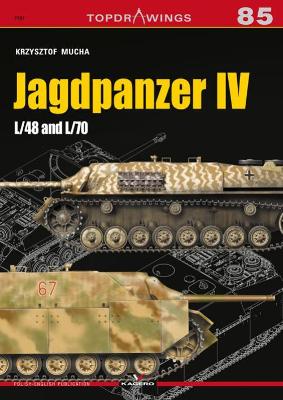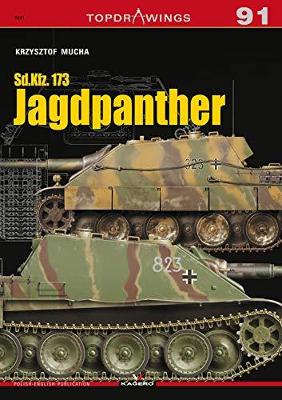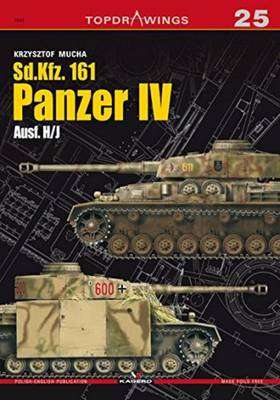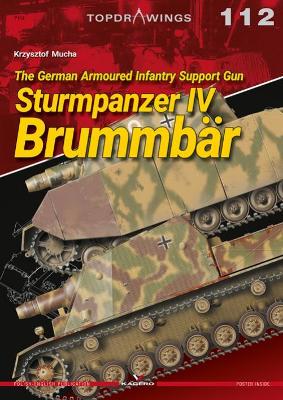Top Drawings
5 total works
The signal of need of such kind of vehicles extension occurred when the struggle against the Soviet Union began. Another ones came from North Africa. In both cases few times turned out that hard-to-eliminate foible of the units equipped with towed guns was its mobility when the tanks and short-barreled assault guns, engaged often and often as the anti-tank artillery, revealed insufficient firepower.
There were self-propelled guns called _Panzerjäger_, put into service in the turn of 1942 and 1943. Despite the fact of being armed with a valuable 75 mm or 76,2 mm main armament, their crews were not protected effectively – the armor plates’ thickness was merely up to 10 mm.
There were self-propelled guns called _Panzerjäger_, put into service in the turn of 1942 and 1943. Despite the fact of being armed with a valuable 75 mm or 76,2 mm main armament, their crews were not protected effectively – the armor plates’ thickness was merely up to 10 mm.
Sd.Kfz. 173 Jagdpanther is a German tank destroyer developed by Krupp and Daimler-Benz. The order was placed in August 1943 and the vehicle entered service in the first months of 1944. It was armed with a very effective anti-tank tank gun. PaK 43 cal. 88 mm. The destroyer’s combat compartment was armoured with 40 to 100 mm thick (front plate) armour plates. From January 1944, 415 pieces were produced (at the MIAG, MNH and MBA factories).
The vehicle was based on the chassis of the Panther Ausf. G, but it didn’t have as many technical problems as the mentioned tank. Due to the favourable power-to-weight ratio, Jagdpanther had good performance and maneuverability. Together with a powerful cannon, which was able to destroy any allied armoured vehicle that time, it made it an extremely effective and dangerous destroyer.
Vehicles were used by independent tank destroyer battalions. Jagdpanthers debuted in Normandy in 1944 (within 555th and 654th Panzerjagerabteilung), achieving great successes. Also during the offensive in the Ardennes, the Allies took a toll on them. They appeared on the Eastern Front in the autumn of 1944, effectively fighting all Soviet armoured guns and heavy tanks, including IS-2.
The vehicle was produced in two main variants. The early version – designated as G1 – had a smaller yoke that was welded to the hull, a modified engine compartment from the Panther Ausf. A and two driver’s visors. In the later version – G2 – the Panther Ausf. G engine compartment was used, one driver’s visor and a larger yoke which was bolted to the front plate with screws. There were also many hybrid variants combining the features of both versions. Until September 1944, Jagdpanthers were covered with Zimmerit in the form of characteristic squares, and not the more popular “snakes”.
Jagdpanthers proved to be the most effective German tank destroyers, but they appeared too late and in too few numbers to significantly influence the course of the war.
The vehicle was based on the chassis of the Panther Ausf. G, but it didn’t have as many technical problems as the mentioned tank. Due to the favourable power-to-weight ratio, Jagdpanther had good performance and maneuverability. Together with a powerful cannon, which was able to destroy any allied armoured vehicle that time, it made it an extremely effective and dangerous destroyer.
Vehicles were used by independent tank destroyer battalions. Jagdpanthers debuted in Normandy in 1944 (within 555th and 654th Panzerjagerabteilung), achieving great successes. Also during the offensive in the Ardennes, the Allies took a toll on them. They appeared on the Eastern Front in the autumn of 1944, effectively fighting all Soviet armoured guns and heavy tanks, including IS-2.
The vehicle was produced in two main variants. The early version – designated as G1 – had a smaller yoke that was welded to the hull, a modified engine compartment from the Panther Ausf. A and two driver’s visors. In the later version – G2 – the Panther Ausf. G engine compartment was used, one driver’s visor and a larger yoke which was bolted to the front plate with screws. There were also many hybrid variants combining the features of both versions. Until September 1944, Jagdpanthers were covered with Zimmerit in the form of characteristic squares, and not the more popular “snakes”.
Jagdpanthers proved to be the most effective German tank destroyers, but they appeared too late and in too few numbers to significantly influence the course of the war.
In June 1943 the production of Pz.Kpfw. IV Ausf. H began in order to increase the armour piercing capabilities of its main armament. Although the new model received the modified 75-mm KwK43 L/48 tank gun, the Ausf. H was still sharing many components with the previous version. This Panzer IV version first saw combat in the summer of 1943 during the German retreat on the Eastern front. The tank proved to be quite complicated and labour-consuming in production which led to simplifying its design. As a result, the less complex Ausf. J model was introduced into production in June 1944.
This book features the monstrous Ausf H variant of the Panzerkampfwagen IV, designated the SD.KFZ 161. This variant saw the integrity of the glacis armour improved by manufacturing it as a single 80-millimetre (3.15 in) plate. To prevent adhesion of magnetic anti-tank mines, which the Germans feared would be used in large numbers by the Allies, Zimmerit paste was added to all the vertical surfaces of the tank's armour. The vehicle's side and turret were further protected by the addition of 5-millimetre (0.20 in) side-skirts and 8-millimetre (0.31 in) turret skirts. These modifications meant its weight shot up, making it a far slower adversary, but a less precarious one.
The Ausf J variant, the final production version of the Panzer IV—the Ausf. J—was considered a retrograde from the Ausf. H. Born of German necessity to replace heavy losses, it was greatly simplified to speed production. By late 1944, Zimmerit was no longer being applied to German armoured vehicles, and the Ausf. J's side-skirts had been replaced by wire mesh, while to further speed production the number of return rollers was reduced from four to three.
About the series
This series of highly illustrated books present detailed scale drawings of aircraft and vehicles, with supporting colour profile artwork. With detailed captions on the history, combat action and development of each machine, each volume is an exceptional reference tool for modellers, with extras such as free decals, masking foil and photo-etched brass.
The Ausf J variant, the final production version of the Panzer IV—the Ausf. J—was considered a retrograde from the Ausf. H. Born of German necessity to replace heavy losses, it was greatly simplified to speed production. By late 1944, Zimmerit was no longer being applied to German armoured vehicles, and the Ausf. J's side-skirts had been replaced by wire mesh, while to further speed production the number of return rollers was reduced from four to three.
About the series
This series of highly illustrated books present detailed scale drawings of aircraft and vehicles, with supporting colour profile artwork. With detailed captions on the history, combat action and development of each machine, each volume is an exceptional reference tool for modellers, with extras such as free decals, masking foil and photo-etched brass.
The German Armoured Infantry Support Gun Sturmpanzer Iv BrummbäR
by Krzysztof Mucha
Published 17 April 2021
Sturmpanzer IV Brummbär (SdKfz 166, Sturmgeschütz IV für 15cm StuH 43) was a German self-propelled assault gun. Work on the design began in 1942 with a goal of creating a vehicle well suited for the demands of urban warfare. The gun was based on the PzKpfw IV Ausf. E and F and, later, Ausf. G. Initially, the vehicle carried 15 cm StuH 43 howitzer, which was later replaced by a bespoke 15 cm StuH 23/1 L/12 weapon. Brummbär went into production in 1943.




